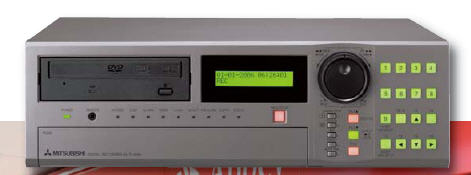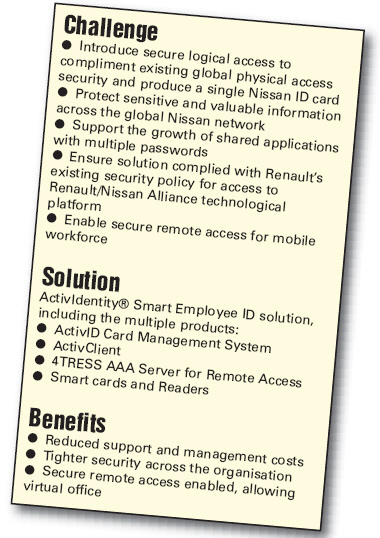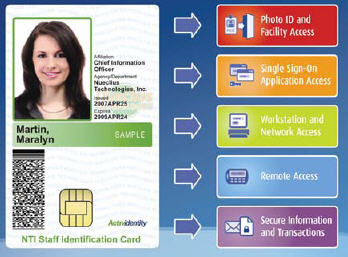Security Upgrade
(a) When it’s time to upgrade surveillance systems
(b) Employee ID cards that work in multiple locations
When it’s time to upgrade surveillance systems
Technology has a tendency to grow ever-more complex, so when Abbey’s security management team were looking to upgrade its branch surveillance systems, they started by understanding what was important to them.
A Security Surveillance system is only as good as its weakest component. Taking this as their starting point, the team at Abbey quickly realised that the baseline objectives of simplicity, flexibility and high product quality were key to success. Achieving these objectives within the context of the complicated legacy of its existing security infrastructure was a challenging task. According to Abbey’s Security Management department, its starting point consisted of a mixture of historic systems and technologies. While the system had for the most part worked adequately well for years, the combination of low-tech hardware and ad-hoc configuration within the different branches was making it increasingly difficult to achieve an adequate level of performance and operational efficiency.
|
|
| The Mitsubishi DX-TL4509E is now standard in branches of Abbey and it is easy for its staff to operate |
Having a different set-up in each branch was clearly not the ideal approach, and they needed to standardise their branch surveillance systems around a flexible digital recording platform. The search for a solution encompassing the required flexibility and simplicity led Abbey to look towards a dedicated Digital Video Recording (DVR) platform for its future requirements. It looked at quite a number of different manufacturers before narrowing its search to those companies it felt were in a position to offer the combination of high-quality, forward-thinking design and product support it was looking for.
Mitsubishi Electric was short-listed. Dean Kemp, sales manager of Mitsubishi Electric security division takes up the story, “Abbey came to us with a straightforward request: They wanted a DVR to do ‘exactly what it said on the tin’. They had a very clear understanding of the features that were important for them, and we had what we felt was the ideal solution for them in the shape of our DX-TL4509E dedicated security recorder.”
Abbey wanted up to nine channels of recording, and a suitable, reliable recording capacity. Simplicity of operation and ease of maintenance were also important, together with a sustainable solution and a degree of future proofing. The Mitsubishi DX-TL4509E fitted those requirements very well, with the added bonus that it is one of the few Kalagate-certified DVRs on the market, making its video evidence admissible in court.
The 9-channel DX-TL4509E is one of a family of purpose-built multi-channel security DVRs. Its features included as standard built in motion detection and a dual multiplexer output that allows for the simultaneous monitoring of both live and recorded footage. Images are recorded using the latest JPEG2000 compression technology, which ensures image capture of the highest clarity. JPEG2000 also allows the still images to be printed from video at extremely high quality. Each of the nine channels can be programmed independently to record at different frame rates up to 100pps. The DX-TL4509E comes as standard with 400Gb of HDD. An expansion bay allows extra HDD capacity to be added if required. Memory can be extended externally up to a massive 7Tb using the optional ZD5UE Hard disk extender box. The Linux-based DX-TL4509E comes with a built-in USB port, CD and DVD R/RW drive, plus the additional benefit of built-in software that automatically embeds a video player onto any CD recording, allowing the footage to be played on any PC without the need for specialist thirdparty video player software. Having the playback software embedded in the player enables staff to get the evidence into the hands of the police within the vital ‘golden hour’ following an incident. If police are able to review evidence immediately without having to wait for specialist viewing equipment, they can be far more responsive and effective.
Most of the components can be swapped on-site in the event of a failure, meaning minimal downtime and very low numbers of box returns. It is also network-ready, paving the way for Abbey to implement a more sophisticated networked system in future with minimal cost penalties.
After detailed and demanding field trials, Abbey specified the DX-TL4509E as its nominated product. The task of carrying out the ambitious refit programme to Abbey’s branch network across the UK fell to Case Security. Installation commenced in May last year and the 2007 programme was completed ahead of the agreed completion date, with the 2008 programme now underway.
In one branch, the DX-TL4509E proved its worth within its first 48 hours of operation because the exceptional quality of its still image performance enabling police to capture a pickpocket in the act of stealing from an Abbey customer’s handbag.
The DX-TL4509E has a sophisticated range of built-in options, including continuous, timed and motion detection recording modes. Simplicity of operation is critical. Regardless of how much training Abbey undertakes with its staff, it recognises that the first time that many staff will have to operate this equipment will be immediately after a real – possibly traumatic – incident. It is therefore essential that the kit is intuitive and easy to operate.
Abbey’s Security Management department is convinced that the high degree of manufacturer support has been instrumental in helping staff achieve a smooth transition to the new technology. “Mitsubishi has really engaged with us by creating very clear user guides and being very pro-active in its support. The support it has given to Case Security has also been exceptional, and it has continued to work with both us and our installers to ensure the programme has progressed smoothly.”
Smart Employee ID
Nissan Europe facilitates the design, engineering, manufacture and sales of Nissan cars from its offices across 34 European countries. With 11,700 employees, it needed a single staff security card solution for all its locations
According to Graham orton, Manager Office Technology & Security, Nissan Europe, “Nissan was looking for an end-to-end security solution to manage user identities integrating smart card technology. This complete and flexible solution enables us to remotely add new access to employee’s services, with a powerful role delegation to local entities in a scalable environment.”
|
|
In 2001, Nissan Japan implemented a physical access solution which allowed its employees to securely access its offices by using a smart card. Orton examined this model and decided to take it one step further by introducing a combined logical and physical access solution to improve security across the organisation. This would compliment the existing physical access security and produce a single Nissan smart employee ID card.
Orton anticipated that this solution would allow employees to securely access and exchange sensitive information across the network, such as details on manufacturing processes and new cars and engines, as well as securely enter any of its 29 European offices. Nissan’s colleagues at Renault also used a secure remote access solution with strong authentication. Therefore, Nissan Europe was obliged to implement a similar solution that would comply with Renault’s existing security policy to ensure access to the Renault/Nissan Alliance technological platform. With 30 per cent of its employees needing secure remote access to the Nissan Europe IT network whether working at home or in any of its European sites, it was vital to implement a flexible, secure solution to facilitate this. All mobile workers also insisted on authenticating the same way whether they connect to the network locally or remotely. Orton wanted to implement a solution which would easily enable a growing number of applications and credentials onto a single dual-chip smart card, rather than two separate cards. His main aim with the proposed solution was to reduce support costs, tighten security, reduce theft of intellectual property and take advantage of the existing Nissan investment. To create a single Nissan ID card, Nissan Europe searched the market for a suitable solution. The team evaluated several card management software and card middleware solutions and selected ActivIdentity Smart Employee ID because it was the only field-proven solution that could scale to 100,000 users. It would also securely update smart cards post-issuance to add applications or credentials as Nissan’s needs evolve.
Nissan Europe heard of ActivIdentity through colleagues in Japan who had used the technology in a middleware deployment in 2002. The success of this project drove the Nissan Europe to also deploy an ActivIdentity solution. The Nissan badges in Japan were already deployed with ActivIdentity software, which simplified the reworking process. The team was also impressed with the smooth integration of the Japanese project and how the ActivIdentity technology could easily manage card selfservice issuance, post-issuance and One-Time Password authentication to a VPN.
Following a successful proof of concept conducted by the Renault/Nissan Alliance, Nissan Europe worked closely with the ActivIdentity team on a two month pilot project. Initially the team tested the technology in one Nissan Europe site, including 30 users. It then extended the pilot for another month across more sites, including an additional 300 users. During the pilot phase, six Nissan CMS administrators were fully trained, five databases were replicated and both operator roles and card profiles were implemented.
|
|
| The Nissan Design Centre, and an example ActivIdentity Smart Employee ID |
The team received positive feedback from the pilot and decided to start the full and live implementation of the project. Nissan Europe decided to implement the ActivID Card Management System (CMS) to manage the issuance and administration of the Nissan ID cards and the ActivIdentity 4TRESS AAA Server to secure and manage strong authentication for remote network access. To establish the framework for the project, the team implemented two CMS servers, one each for both Northern and Southern Europe. A new set of card profiles were designed according to Nissan requirements, taking into account both the existing cards in Japan and future PKI needs. Different operator roles were also created to match Nissan’s SSO and VPN needs and support local helpdesk and security teams. The implementation went well and in just three months over 5,500 employees could use their Nissan ID cards everyday for both physical and logical access. ActivIdentity was involved in the design and implementation phases of the project and worked closely with the Nissan Europe team to ensure the solution went live in June 2005.
Currently, over 7,500 users across 29 European offices are using a smart employee ID card, including users in France, UK, Spain, Italy, Germany, Netherlands, Denmark, Norway, Sweden, Finland, Poland, Czech Republic, Hungary, Russia, Kazakhstan, Ukraine, Switzerland and Belgium. Each site was responsible for its own deployment, coordinated by one single European project manager and users initialised the cards themselves. Card initialisation was completed with less than two per cent failure and the project was heavily supported and praised by the executive management team.
Communicating and promoting the use of the Nissan ID card to all end users was vital to the success of the project. The team held internal workshops for all local helpdesk agents, pilot users, executive management and all Nissan Europe ID card users. Posters were also created and displayed in all offices to remind users that they would be unable to log-on to the network or enter the building without their personal Nissan ID card.
With over 7,500 employees using the Nissan ID card, the organisation reduced its helpdesk and support costs by 40 per cent by spending less time on dealing with password-related requests. The organisation noticed a significant reduction in calls to the helpdesk by deploying the ActivID Card Management System. The software enabled users to directly report smart card-related incidents and rectify any issues, such as lost or damaged smart cards, via an online web console. The Alliance solution also reduced the global investment cost by 50 per cent.
The Nissan ID cards boosted Nissan Europe’s overall security and enabled the organisation to establish a standard secure IT infrastructure across 29 offices in Europe. Standardised authentication management ensured that the organisation could protect sensitive and valuable information across the global Nissan network.
The flexible and efficient solution from ActivIdentity enables Nissan staff to remotely create new smart employee ID cards via a strong and secure online portal. All mobile workers can now securely access vital company information across all sites.


